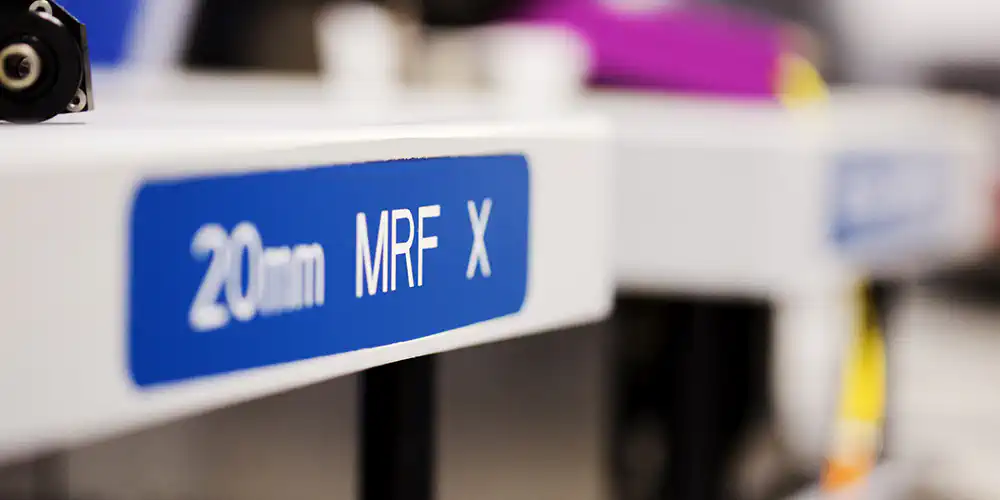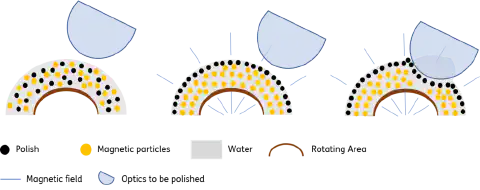
Magnetorheological Polishing
High-End-Finishing Part 2 - Magnetorheological Finishing (MRF)
Content
After considering the correction process by ions (ION-FinishTM), this blog post will focus on magnetorheological finishing (MRF). This correction method is a mechanical polishing process for optical surfaces. Targeted, local material removal corrects the optical surface and enables lowest surface roughness values (Rq < 0.3 nm). MRF technology enables the flexible design of high-quality precision optics by using the magnetorheological properties of the material components.
The Procedure
The MRF correction procedure works with a magnetorheological fluid consisting of magnetic particles, polishing agents and water. The MR fluid is continuously applied to a rotating wheel via a nozzle (see Fig. 1). Below the wheel surface is a magnet for generating a magnetic field that changes the viscosity of the “intelligent” fluid. The iron particles align and form a stiff structure adhering to the wheel; water and abrasive particles concentrate as a solidified, thin polishing layer on the surface (see Fig. 2). The workpiece is clamped in a movable holder and dipped into the polishing layer on the surface to be machined. Polishing of the workpiece surface begins (see Fig. 3). The position of the workpiece can be positioned fully automatically to save time. Targeted material removal enables the local correction of shape errors. This results in the lowest surface roughness values for optics of highest quality. MRF technology is characterized by maximum precision, determinism and repeatability in the manufacture of precision optics.
Figure: Process steps of MRF procedure
Advantages of MRF Technology
The MRF process impresses with its polishing and correction possibilities in the short-wave and long-wave range. The high determinism is reflected in very good error correction planning, which leads to best results in the polish. In addition, the process convinces through its simple applicability. The high flexibility of the MRF process allows easy adaptation to a wide variety of optical surfaces. Therefore, many optical components can be manufactured for a wide range of applications.
The following advantages can be noted for the correction procedure:
| Machining Accuracy: | High Precision Surface Accuracy (λ/50) |
| Determinism: | Very good repeatability |
| Flexibility: | Adapts to a wide variety of surface shapes |
Fields of Application
The MRF refinement process has a wide range of applications because of the variety of optics that can be manufactured. Different geometries for the short- and long-wave range are easily attainable. Therefore, polishing within the framework of MRF technology can be carried out on classical optical elements such as spheres as well as on more complex surfaces such as aspheres (or free form optics). For example, lenses for microscopy are polished using MRF technology in order to keep scattered light to a minimum and generate razor-sharp images. The demands placed on optics installed in LIDAR systems are also very high, as they are exposed to particularly high environmental influences such as the sun and thus to particular heat. In order to guarantee optimum functionality, the optical components require a perfect optical surface, which can be provided by MRF technology.

